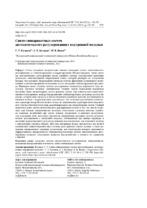| dc.contributor.author | Кулаков, Г. Т. | |
| dc.contributor.author | Кулаков, А. Т. | |
| dc.contributor.author | Воюш, Н. В. | |
| dc.coverage.spatial | Минск | ru |
| dc.date.accessioned | 2022-12-08T05:53:13Z | |
| dc.date.available | 2022-12-08T05:53:13Z | |
| dc.date.issued | 2022 | |
| dc.identifier.citation | Кулаков, Г. Т. Синтез инвариантных систем автоматического регулирования с внутренней моделью = Synthesis of an Invariant Automatic Control Systems with an Internal Model / Г. Т. Кулаков, А. Т. Кулаков, Н. В. Воюш // Известия высших учебных заведений и энергетических объединений СНГ. Энергетика. – 2022. – № 6. – С. 539-550. | ru |
| dc.identifier.uri | https://rep.bntu.by/handle/data/123351 | |
| dc.description.abstract | Статья посвящена модернизации типовых каскадных систем автоматического регулирования со стабилизирующим и корректирующим ПИ-регуляторами. Такие системы автоматического регулирования кроме основного сигнала (регулируемой величины) используют дополнительный опережающий сигнал, который реагирует на возмущение быстрее, чем основной. Опережающий сигнал достаточно эффективно компенсирует возникающие в системе внутренние возмущения за счет настройки стабилизирующего регулятора. Примером может служить система регулирования температуры перегретого пара котельных агрегатов тепловых электрических станций. Задача определения параметров настройки таких двухконтурных систем довольно сложна. При относительно малой инерционности внутреннего контура быстродействие стабилизирующего регулятора достаточно высоко, и переходные процессы в нем не оказывают влияния на качество регулирования во внешнем контуре с корректирующим регулятором. Это позволяет рассчитывать оптимальные параметры настройки последнего только по динамическим характеристикам инерционного участка обычными методами, разрабатываемыми для одноконтурных систем. Главный недостаток таких систем автоматического регулирования состоит в том, что они не позволяют при близких инерционностях контуров существенно улучшить качество отработки основных воздействий при скачке задания, внутреннего и внешнего возмущения. Для устранения этого недостатка предложена инвариантная каскадная система автоматического регулирования с внутренней моделью, учитывающей при выборе структуры и настройке корректирующего регулятора динамику как внутреннего, так и внешнего контура с инерционным участком объекта. При этом внутренняя модель используется для полной компенсации главной обратной связи системы при отработке сигнала задания, а также выделения эквивалентного внешнего возмущения, для компенсации которого применяется дифференциатор инвариантности. Инвариантная каскадная система автоматического регулирования позволяет существенно повысить быстродействие и точность по сравнению с типовой. | ru |
| dc.language.iso | ru | ru |
| dc.publisher | БНТУ | ru |
| dc.title | Синтез инвариантных систем автоматического регулирования с внутренней моделью | ru |
| dc.title.alternative | Synthesis of an Invariant Automatic Control Systems with an Internal Model | ru |
| dc.type | Article | ru |
| dc.identifier.doi | 10.21122/1029-7448-2022-65-6-539-550 | |
| local.description.annotation | The article is devoted to the modernization of typical cascade automatic control systems
with stabilizing and corrective PI controllers. Such automatic control systems, in addition to the
main signal (of adjustable value), use an additional leading signal that reacts to the disturbance
faster than the main one. The leading signal effectively compensates for internal disturbances
arising in the system by adjusting the stabilizing controller. The temperature control system
of superheated steam boiler units of thermal power plants may be taken as an example. The task
of determining the configuration parameters of such dual-circuit systems is quite difficult.
With a relatively low inertia of the internal circuit, the speed of the stabilizing controller is quite
high, and transients in it do not affect the quality of regulation in the external circuit with a corrective
controller. This makes it possible to calculate the optimal settings of the latter only by
the dynamic characteristics of the inertial section using conventional methods developed for
single-circuit systems. The main disadvantage of such automatic control systems is that they
do not allow, with close inertia of the contours, to significantly improve the quality of working out
the main impacts during the jump of the task, internal and external disturbances. To eliminate this
drawback, an invariant cascade automatic control system with an internal model is proposed that
takes into account the dynamics of both the internal and external contours with an inertial section
of the object when choosing the structure and setting up the corrective controller. In this case,
the internal model is used to fully compensate for the main feedback of the system when working
out the task signal, as well as to isolate an equivalent external disturbance, for which an invariance
differentiator is used to compensate. The invariant cascade automatic control system makes
it possible to significantly increase the speed and accuracy compared to the standard one. | ru |

